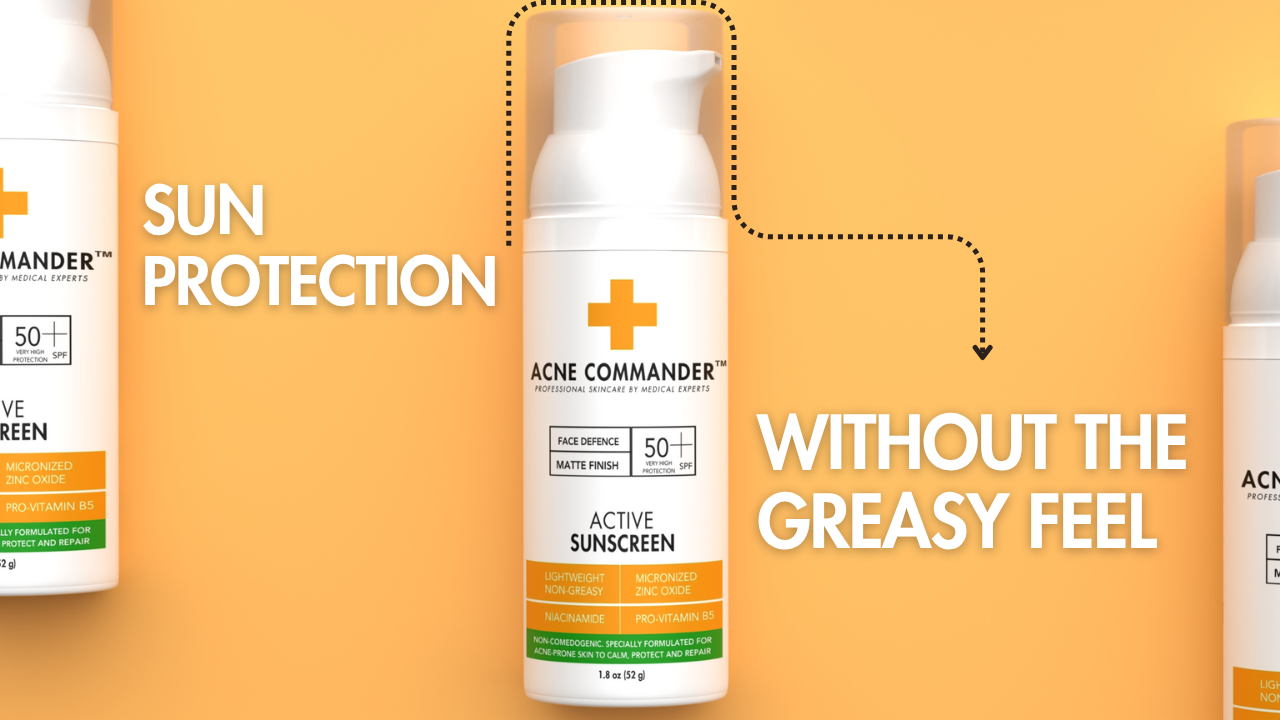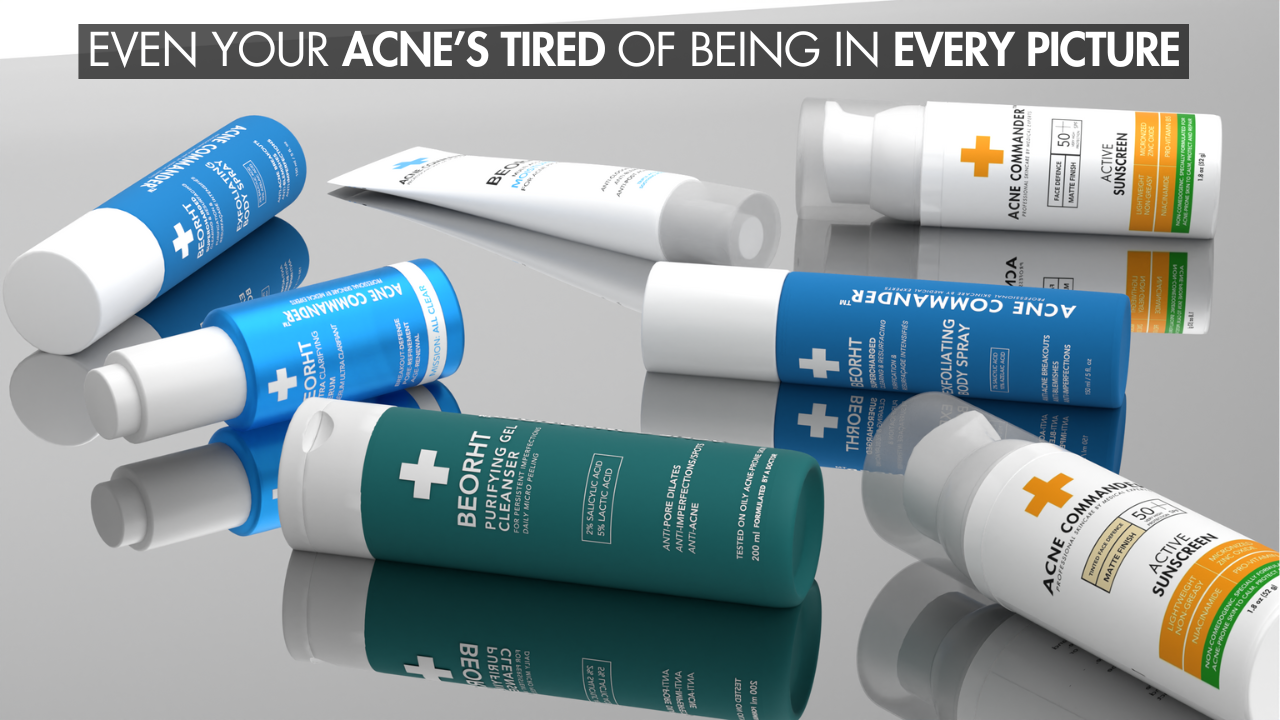Introduction: Why Acne-Prone Skin Needs Custom Moisture Solutions
Acne-prone skin is a battlefield, with excess oil, clogged pores, breakouts, redness, and sensitivity. But the biggest mistake many people make is avoiding moisturizers altogether. In truth, moisturizing is not only safe for acne, it’s essential.
So, how do you find a moisturizer that helps acne instead of making it worse? Better yet, how do you make one yourself at home that’s tailored to your skin’s needs, free from comedogenic fillers, harsh preservatives, or irritating fragrances?
In this article, you’ll learn:
-
How to make your own moisturizer for acne-prone skin step-by-step
-
Which ingredients are safe (and which to avoid)
-
The difference between hydrating, soothing, and pore-clogging
-
Why DIY might work in early stages, but clinical options like Acne Commander 3-in-1 Repairing Moisturiser outperform in persistent cases
Let’s dive in and take full control of your skincare, starting with science.
Why Moisturizer Is a Must for Acne-Prone Skin
Contrary to popular belief, people with acne often have dehydrated skin, not just oily skin. The skin produces more oil to compensate for lack of moisture, leading to even more clogged pores.
Skipping moisturizer:
-
Worsens the oil imbalance
-
Disrupts the skin barrier
-
Triggers more breakouts
-
Prolongs post-acne marks
Using the right moisturizer calms inflammation, supports healing, regulates sebum production, and helps prevent scarring.
Key Requirements of a DIY Moisturizer for Acne-Prone Skin
Whether homemade or commercial, a good moisturizer should be:
-
Non-comedogenic (won’t clog pores)
-
Fragrance-free and alcohol-free
-
Rich in humectants and barrier-repairing agents
-
Soothing and anti-inflammatory
-
Balanced, not too greasy, not too drying
3 Functional Categories in Every Moisturizer
|
Function |
Examples |
Purpose |
|
Humectants |
Glycerin, Aloe Vera, Honey |
Attract water to the skin |
|
Emollients |
Jojoba oil, Squalane, Rosehip |
Smooth, soft skin |
|
Occlusives (optional) |
Beeswax, Shea Butter |
Lock in moisture, protect |
Acne-prone skin typically needs more humectants and emollients, and minimal occlusives unless it’s also dry or compromised.
Best Ingredients for DIY Acne Moisturizers
✅ Safe, Skin-Loving Ingredients
-
Glycerin – Humectant, deeply hydrating and barrier-supportive
-
Aloe Vera Gel – Soothes irritation and lightly hydrates
-
Jojoba Oil – Closely mimics natural sebum, non-comedogenic
-
Squalane – Lightweight oil with antioxidant properties
-
Rosehip Seed Oil – Rich in Vitamin A, supports healing
-
Honey (Manuka preferred) – Antibacterial and humectant
❌ Ingredients to Avoid
-
Coconut Oil – Highly comedogenic (pore-clogging)
-
Olive Oil – Moderate clogging risk
-
Fragrance or Essential Oils – Trigger sensitivity and breakouts
-
Unrefined Butters – Often too heavy for the face
-
Milk or Yogurt – May irritate or spoil quickly
-
Raw Eggs – Risk of bacterial contamination
Step-by-Step: How to Make Moisturizer for Acne-Prone Skin
Let’s walk through three beginner-friendly DIY moisturizer recipes tailored to acne-prone skin.
Recipe 1:
Aloe + Glycerin Gel Moisturizer
Ideal for: Oily, inflamed, breakout-prone skin
Ingredients:
-
2 tbsp pure aloe vera gel (preservative-free or store-bought)
-
1 tsp vegetable glycerin
-
1/2 tsp jojoba oil (optional for combo skin)
-
1 capsule of vitamin E (optional antioxidant)
Instructions:
-
Mix aloe vera and glycerin in a clean bowl.
-
Add jojoba oil and vitamin E if desired.
-
Blend until fully combined.
-
Store in a sterilized glass jar in the refrigerator.
-
Use morning and evening.
Shelf Life: 5–7 days
Recipe 2:
Squalane + Calendula Healing Cream
Ideal for: Sensitive acne-prone skin with red patches
Ingredients:
-
1 tbsp squalane oil
-
1 tsp calendula-infused oil or extract
-
1 tsp aloe vera gel
-
1/2 tsp glycerin
Instructions:
-
Mix all oils first.
-
Slowly add aloe and glycerin.
-
Whisk into a smooth blend.
-
Store in a cool, dark container.
-
Use at night or under sunscreen in the day.
Recipe 3:
Honey + Rosehip Night Balm
Ideal for: Acne with dark spots or scarring
Ingredients:
-
1 tsp raw or Manuka honey
-
1 tsp rosehip seed oil
-
1 tsp aloe vera gel
Instructions:
-
Warm honey gently if thick.
-
Mix with oils and aloe.
-
Store airtight in the fridge.
-
Use at night for regeneration.
Hygiene and Storage Guidelines
-
Sterilize all tools before use.
-
Use distilled water only if absolutely necessary.
-
Always use spatulas, not fingers.
-
Store in the fridge in airtight jars.
-
Make small batches (lasts 5–10 days max).
Common Mistakes When Making Acne Moisturizer
❌ Using random oils that clog pores
❌ Adding essential oils “for scent”
❌ Keeping products too long without preservation
❌ Not pH-testing, leads to irritation
❌ Using unwashed hands or dirty tools
Why Homemade Moisturizers Sometimes Fail
DIY is great for experimentation, but acne-prone skin often requires more precise pH, targeted actives, and tested non-comedogenic formulas.
That’s why many people eventually switch to trusted products like Acne Commander 3-in-1 Repairing Moisturiser, especially if:
-
Acne is persistent
-
Redness and texture issues are worsening
-
Scarring is developing
-
Natural options are not showing visible improvement
Why Acne Commander 3-in-1 Moisturiser Beats Most DIY Formulas
|
Feature |
Acne Commander |
DIY Moisturizer |
|
Clinically tested |
✅ |
❌ |
|
Contains exfoliating actives |
✅ (Salicylic Acid, Capryloyl SA) |
❌ |
|
Microbiome balancing |
✅ (Vitreoscilla Ferment) |
❌ |
|
Barrier repair |
✅ (2-Oleamido-1,3-Octadecanediol) |
❌ |
|
Anti inflammatory actives |
✅ (Niacinamide, Zinc PCA) |
❌ |
|
Stable shelf life |
✅ (preserved & pH-balanced) |
❌ |
Full Ingredient Analysis of Acne Commander
Some standout ingredients that put this product above homemade blends:
-
Niacinamide – Calms inflammation, brightens, minimizes pores
-
Salicylic Acid + Capryloyl SA – Penetrates pores and clears acne
-
Zinc PCA – Controls oil production and supports healing
-
Vitreoscilla Ferment – Balances skin microbiome
-
2-Oleamido-1,3-Octadecanediol – Strengthens skin barrier
-
Glycerin + Mannose – Deep hydration
-
Pomegranate Extract – Antioxidant and anti-redness
-
Squalane, Panthenol, Allantoin – Soothe, repair, and hydrate
Transitioning from DIY to Clinical-Grade Moisturizers
If DIY hasn’t resolved your breakouts or you want to upgrade, here’s how to make the switch safely:
-
Pause DIY for 48–72 hours
-
Start with a patch test of Acne Commander
-
Apply once daily for the first 3 days
-
Move to twice daily application
-
Monitor changes for 14–21 days
FAQs About Making Moisturizer for Acne-Prone Skin
❓ Is it safe to make moisturizer at home?
Yes, if you use non-comedogenic ingredients, clean tools, and store it properly.
❓ Can coconut oil be used?
No. It clogs pores and worsens acne in most people.
❓ Can a homemade moisturizer treat acne?
It may soothe and hydrate, but will not exfoliate or treat breakouts deeply like salicylic acid or zinc PCA in professional formulas.
❓ How long do DIY moisturizers last?
Typically 5–10 days in the fridge. Avoid water-based formulas unless you know how to preserve them.
❓ Should I make separate moisturizers for day and night?
You can, lighter formulas for day, more nourishing ones at night.
Conclusion: Make It, But Make It Safe and Smart
Making your own moisturizer for acne-prone skin is empowering and can be effective for hydration, barrier support, and reducing inflammation, especially when store-bought options have failed you.
But homemade products are limited by their lack of active acne-fighting ingredients, clinical testing, and preservation.
If your skin needs more than hydration, like clearing pores, reducing oil, repairing damage, and balancing the microbiome, then it’s time to move to a high-performance solution like Acne Commander 3-in-1 Repairing Moisturiser.
It combines the simplicity of clean ingredients with the power of science-backed actives, so you can stop experimenting and start healing.





